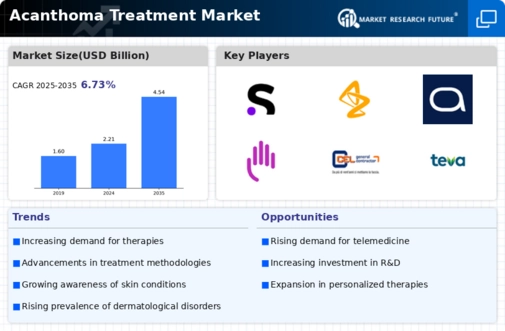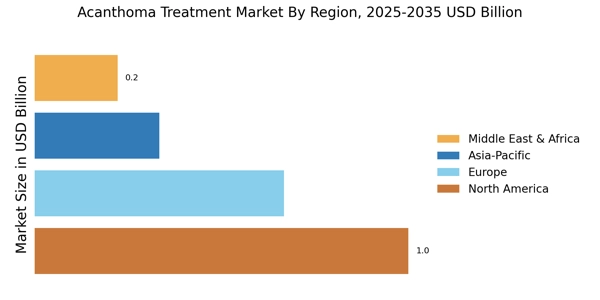Growing Awareness and Education
The increasing awareness and education regarding skin health are crucial drivers for the Acanthoma Treatment Market. Public health campaigns and educational initiatives by dermatological associations have significantly improved knowledge about skin disorders, including acanthoma. As individuals become more informed about the symptoms and risks associated with acanthoma, they are more likely to seek medical advice and treatment. This heightened awareness is reflected in the rising number of dermatology consultations and screenings. Consequently, healthcare systems are adapting to meet this demand, leading to an expansion of services within the Acanthoma Treatment Market. The emphasis on preventive care and early intervention is likely to further bolster market growth.
Increasing Incidence of Acanthoma
The rising incidence of acanthoma is a pivotal driver for the Acanthoma Treatment Market. As populations age, the prevalence of skin disorders, including acanthoma, appears to increase. Recent estimates suggest that skin cancers, including non-melanoma types, account for a substantial portion of dermatological conditions. This trend necessitates effective treatment options, thereby propelling the demand for innovative therapies. Furthermore, the growing awareness of skin health and the importance of early diagnosis contribute to the increasing number of patients seeking treatment. Consequently, healthcare providers are likely to expand their offerings in the Acanthoma Treatment Market to address this burgeoning patient population.
Advancements in Treatment Modalities
Technological innovations in treatment modalities are significantly influencing the Acanthoma Treatment Market. Recent developments in laser therapy, cryotherapy, and topical agents have enhanced treatment efficacy and patient outcomes. For instance, laser treatments have shown promising results in reducing lesion size and improving skin texture. The introduction of minimally invasive procedures is likely to attract more patients, as they often result in shorter recovery times and reduced discomfort. Moreover, the market is witnessing a surge in research and development activities aimed at discovering novel therapeutic agents. This focus on innovation is expected to drive growth in the Acanthoma Treatment Market, as healthcare providers seek to offer the most effective and patient-friendly treatment options.
Rising Demand for Non-Invasive Treatments
The growing preference for non-invasive treatment options is shaping the Acanthoma Treatment Market. Patients increasingly favor procedures that minimize discomfort and downtime, leading to a shift towards non-invasive therapies such as topical treatments and photodynamic therapy. This trend is particularly evident among younger demographics who prioritize convenience and quick recovery. As a result, healthcare providers are adapting their treatment protocols to incorporate these less invasive options, thereby enhancing patient satisfaction. The demand for non-invasive treatments is expected to continue rising, prompting further innovation and investment in the Acanthoma Treatment Market. This shift not only benefits patients but also encourages providers to explore new therapeutic avenues.
Regulatory Support and Reimbursement Policies
Supportive regulatory frameworks and favorable reimbursement policies are vital drivers for the Acanthoma Treatment Market. Governments and health authorities are increasingly recognizing the importance of addressing skin disorders, leading to the establishment of guidelines that facilitate access to treatment. Additionally, many insurance providers are expanding coverage for dermatological treatments, including those for acanthoma. This financial support encourages patients to seek necessary care without the burden of high out-of-pocket costs. As reimbursement policies evolve to include a broader range of treatment options, the Acanthoma Treatment Market is likely to experience accelerated growth. This regulatory environment fosters innovation and encourages healthcare providers to invest in new therapies.


















Leave a Comment